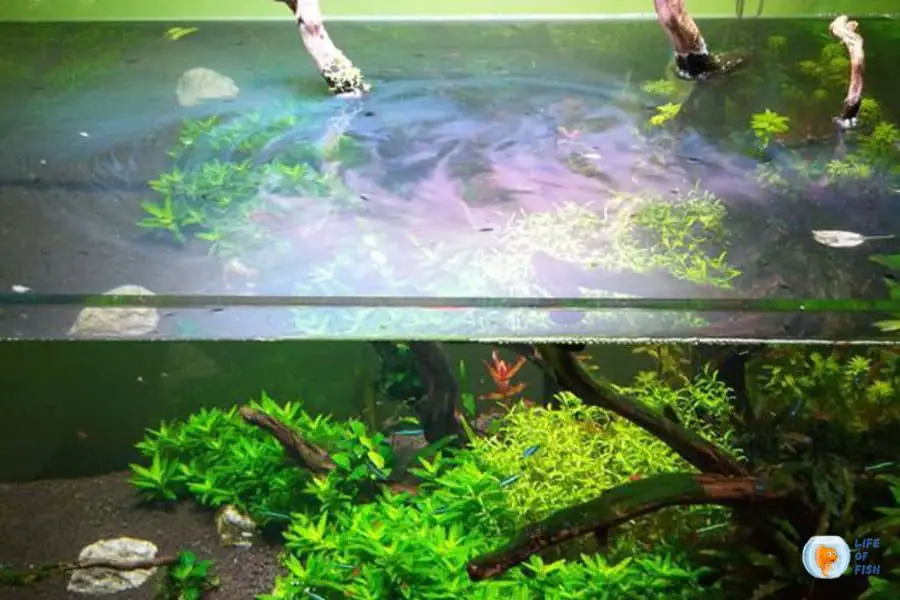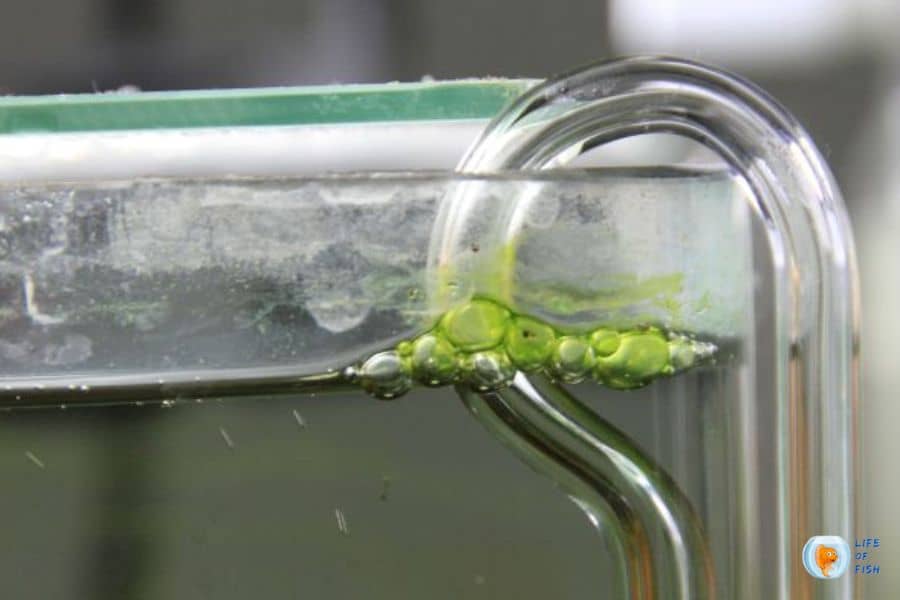From time to time, you may notice a layer of “oily slick” on the top of your aquarium, whether it’s a saltwater or freshwater aquarium. These films are what we call “biofilms”! But why biofilm on top of aquarium water?
You do not have to worry about them. These films are not harmful to your plants or fish. But, there is a certain amount of biofilm that your fish tank can tolerate. So, it is better to remove the biofilm before it gets too thick.
This article will explain everything you need to know about biofilms in aquariums, such as what they are, why they develop, and how to eliminate them. You will also learn about the benefits and drawbacks of biofilm.

What is Biofilm?
Jump To
- 1 What is Biofilm?
- 2 Benefits and Drawbacks of Biofilm
- 3 Why Does My Aquarium Water Have A Film On Top?
- 4 What Happens If Biofilm Is Not Removed?
- 5 Can You Filter Out Biofilm?
- 6 How Do You Remove Biofilm From The Top Of An Aquarium?
- 7 How Long Does It Take To Get Rid Of Biofilm In an Aquarium?
- 8 How To Prevent Biofilm In Aquariums?
- 9 Final Thoughts
- 10 Refernces
- 11 FAQ
- 12 Is Biofilm Harmful To Fish?
According to Dr. Dolan (A plant scientist), Biofilm is a collection of microorganisms that attach to surfaces and secrete a sticky substance that helps them adhere to one another. This substance is made up of extracellular polymeric substances (EPS), which are composed of carbohydrates, proteins, and DNA.
The microorganisms in the biofilm can be bacteria, fungi, algae, or even protozoa. In fact, biofilms can contain a mixture of all of these microorganisms. Biofilm forms when microorganisms attach to surfaces and secrete EPS. The microorganisms in a biofilm can be beneficial or harmful to your aquarium.
Benefits and Drawbacks of Biofilm
According to two scientists Westall and Rincé, biofilm can provide a number of benefits, such as:
- Acting as a food source for your fish and other aquatic creatures.
- Helping to keep your aquarium clean by trapping debris and bacteria.
- Acting as a substrate for beneficial bacteria to colonize.
- Stabilizing pH levels in your aquarium.
However, there are also some drawbacks to biofilm. One of the most significant drawbacks is that it can become a breeding ground for harmful bacteria that cause disease. Another drawback of biofilm is that it can make your aquarium look dirty and unkempt. This is the very reason why most aquarists choose to remove biofilm from their aquariums on a regular basis.
Why Does My Aquarium Water Have A Film On Top?
As explained above, biofilm appears when microorganisms secrete certain substances. These substances can be either natural or man-made. There can be a number of ways that aquariums develop a biofilm.
Fish Waste
Since fish are live creatures, they produce waste. This waste can contribute to the formation of biofilm in your aquarium as they contain nutrients that microorganisms need to grow and thrive.
Uneaten Food
Uneaten food is another common source of biofilm in aquariums. When fish eat, they leave behind bits of food that can decompose and release nutrients that microorganisms need to grow. This often happens when you overfeed your fish.
Decaying Plants
When plants die, they decompose and release nutrients that microorganisms need to grow. This can contribute to the formation of biofilm in your aquarium.
Excess Fertilizers
Some aquarists put on more fertilizers than their plants can use. This can lead to a build-up of nutrients in the water, which can then be used by microorganisms to form biofilm.
Cleaner Shrimp, Crab, and other Cleaning Crews
While it may seem counterintuitive, the very creatures you have in your aquarium to keep it clean can actually contribute to the formation of biofilm. This is because these creatures disturb the substrate, which can release nutrients that microorganisms need to grow.
Insufficient Filtration
If your aquarium is not properly filtered, waste and debris can build up in the water, which can provide nutrients for microorganisms to grow. This can lead to the formation of biofilms.
Oil From Your Hands
You may not believe it, but the oil from your hands can contribute to biofilm formation in your aquarium. This is because the oil can coat surfaces and provide nutrients that microorganisms need to grow.
What Happens If Biofilm Is Not Removed?
A small layer of biofilm doesn’t harm your inner ecosystem. In fact, it can actually be beneficial as it provides a food source and helps to keep your aquarium clean. However, if the biofilm is not removed, it can quickly become harmful.
- It will trap debris and bacteria.
If the biofilm is not removed, it will continue to grow and can trap debris and bacteria. This can lead to water quality issues, such as ammonia spikes and nitrate build-up. In extreme cases, biofilm can even lead to a complete breakdown of your aquarium’s ecosystem.
- Biofilm may become a breeding ground for harmful bacteria.
Biofilm can also become a breeding ground for harmful bacteria that cause disease. If these bacteria are not removed, they can spread to your fish and other aquatic creatures, causing them to become sick.
- Biofilm consumes oxygen
Since biofilm is a microorganism, it consumes oxygen to thrive. When your aquarium is full of biofilm, it may consume all the oxygen that would otherwise diffuse into the water. When the oxygen levels of the tank dip too low, it will put stress on your fish, which may cause them to die.

Can You Filter Out Biofilm?
While you can not filter out biofilm through a filter, you can prevent it from forming in the first place. For this, you will need an aquarium filter powerful enough to remove waste and debris from the water. A good aquarium filter will also help keep your water parameters in check, further preventing biofilm from forming.
To keep biofilm from forming, you’ll have to point your filter nozzle at the water surface where the biofilm is growing. This will help to break up the biofilm and remove it from the water. You may need to repeat this procedure a few times to totally remove the biofilm.
How Do You Remove Biofilm From The Top Of An Aquarium?
The most common approaches to eliminate biofilm from the top of your aquarium are as follows:
Use a Paper Towel
If you want to remove biofilm from the top of aquarium water immediately, a paper towel is a way to go. Paper towels can easily absorb water, making them ideal for soaking up biofilm. To use a paper towel to remove biofilm, you should first turn off any filters, pumps, and power heads because they make the paper towel break apart and float away.
After turning off all equipment, gently lay the paper towel on top of the water surface where the biofilm is growing. You should then wait a few seconds for the paper towel to absorb the water. Once the paper towel has soaked up the water, you can simply lift it out of the tank and dispose of it.
Use a Surface Skimmer
One of the best ways to deal with biofilm is to use a surface skimmer. As the name suggests, a surface skimmer is a device that sits on the surface of your aquarium and sucks up any floating oil, algae, and bacteria. This prevents the buildup of biofilm and keeps your aquarium looking clean and healthy.
As for the efficiency of this device, it will take only minutes to completely remove biofilm from the top of your aquarium. This is because surface skimmers are designed to work quickly and efficiently. The only downside to using a surface skimmer is that it can be quite expensive. A surface skimmer, on the other hand, is unquestionably worth investing in if you have the money for it.
How Long Does It Take To Get Rid Of Biofilm In an Aquarium?
If you use a surface skimmer, you can remove biofilm from your aquarium in just a few minutes. However, if you use the paper towel method, biofilm may come back even if you get rid of all the biofilm at once. This is because the paper towel method does not prevent biofilm from forming. It only removes it temporarily. In order to completely get rid of biofilm in your aquarium, you need to take preventive measures to prevent it from forming in the first place.
How To Prevent Biofilm In Aquariums?
The easiest method to avoid biofilm from forming in your aquarium is to keep the water clean and free of debris. This can be done by using a powerful filter and performing regular water changes.
Another way to prevent biofilm from forming is to increase the water flow in your aquarium. This can be done by using power heads or by adding more air pumps and/or filters. The increased water flow will keep the biofilm from attaching to surfaces and will make it easier to remove.
You can also add plants to your aquarium because they help keep the water clean by absorbing nutrients and releasing oxygen. Plants also help to prevent biofilm from forming because they compete with bacteria for space and food. Some other ways to control nutrients in the aquarium are by controlling the crowding of fish, overfeeding, and using a protein skimmer.
Last but not least, you can use chemicals to control biofilm. Chemicals such as copper and silver are known to be effective against biofilm. You can also use hydrogen peroxide to control biofilm. However, using chemicals should be a last resort because they can be harmful to your fish and plants, especially scaleless fish, shrimp, and snails.
Final Thoughts
Biofilm is a naturally occurring phenomenon and is usually not something to be worried about. While it can become harmful if left unchecked, it is relatively easy to deal with. Just remember to take preventive measures to prevent it from forming in the first place, and you should be fine.
Refernces
- Donlan R M, Biofilms: Microbial life on surfaces, Emerg. Infect. Dis, 8 (2002) 881-890
- Westall, F. and Rincé, Y., 1994. Biofilms, microbial mats and microbe‐particle interactions: electron microscope observations from diatomaceous sediments. Sedimentology, 41(1), pp.147-162.
FAQ
Is Biofilm Good Or Bad for Aquariums?
This is a difficult issue to tackle since biofilm might be both beneficial and harmful to an aquarium. On the one hand, biofilm provides a surface for beneficial bacteria to colonize and helps keep the water clean. On the other hand, biofilm can also harbor harmful bacteria and toxins that can be damaging to fish and other aquatic life.
In general, biofilm is not something that you need to worry about unless it becomes excessive. If you see a small amount of biofilm in your aquarium, it is nothing to be concerned about. However, if the biofilm starts to build up and becomes excessive, you may need to take action to remove it.
Is Biofilm Harmful To Fish?
A moderate amount of biofilm is not harmful to fish and can actually be beneficial. However, an excessive amount of biofilm can be harmful to fish because it can harbor harmful bacteria and toxins. If you see a large amount of biofilm in your aquarium, it is best to remove it to prevent any harm to your fish.
Read Next : Green Aquarium Water : Quick And Easy Solution
